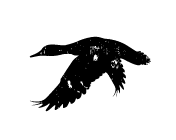The West promises big adventure and hard-gobbling turkeys. And from all indications, Spring 2024 could be another memorable season.
Traveling turkey hunters love the West, from its broad prairies to snow-capped mountains. And the hunting is usually top-notch, too. That should be the case during Spring 2024, as biologists across the region say turkey numbers — with a few localized exceptions — are thriving. So, if you want to stretch your legs and yelp to birds that are a bit different than those tough Easterns back home, this could be your year.
Here’s a state-by-state look at what Western turkey hunters can expect this spring.

Go win the West and bag a few big-country longbeards. Image by GizmoPhoto
Arizona
Rick Langley, wildlife program manager with the Arizona Game and Fish Department, said he expects 2024 turkey hunting prospects to be better than average in the northern and eastern portions of the state, but perhaps average or slightly below average throughout the rest of Arizona.
“We have had a couple of years of good poult production and good precipitation patterns in the northern and eastern units, but the central part of the state has been hit with really dry summers and some precipitation events that may have hurt some localized flocks,” he said.
Units 1 and 27 in eastern Arizona look especially promising, as does Unit 12A in the northern part of the state. “With last winter’s heavy snowfall across the central part of the state (Flagstaff to Payson), local wildlife managers felt like they had birds die where they were not able to access suitable winter range,” Langley said.
Arizona holds mostly Merriam’s, about 3,000 Gould’s and a few Rio Grandes, Langley said. In 2023, 3,608 hunters spent 13,186 days to harvest 853 turkeys, or about a 24% success rate.
Read More: Turkey Hunting in Arizona
California
The Golden State holds mostly Rio Grande turkeys, with some Easterns, Merriam’s and Eastern/Rio Grande hybrids in the northern part of the state. And the outlook for 2024 is good.
“State biologists’ models indicate the turkey population is stable statewide, increasing in recent years with more favorable winter rain,” said Matt Meshriy, environmental scientist with the California Department of Fish and Wildlife’s upland game program. “Regionally, current wild turkey abundance indices are highest in the Sierra Nevada, San Francisco Bay and central coast, and Central Valley.” Preliminary Spring 2023 harvest results were down slightly from those of 2021, when hunters took about 20,795 birds.
Read More: Turkey Hunting in California
Colorado
Ed T. Gorman, small-game manager for Colorado Parks and Wildlife, said 2024 turkey prospects look to be on par with those of the previous few seasons.
“We’ve seen some population declines in some areas but not widespread declines,” he said. “So much of the turkey outlook is influenced by weather, and we are awfully early in our winter period. The South Platte River could be down a bit since it flooded during the last nesting season.”
The Centennial State has Merriam’s and Rio Grandes. In 2023, hunters took about 5,694 birds.
Read More: Turkey Hunting in Colorado
Hawaii
Yep, the Big Island has a solid Rio Grande population and offers spring hunting. Jason Omick, wildlife biologist with the Hawaii Department of Land and Natural Resources’ Division of Forestry and Wildlife, said 2024 prospects shouldn’t be significantly different than those of the past two or three years. And pending approval, the department will be adding turkey hunting opportunities on the island of Hawaii for the upcoming season.
“The turkey harvest has slightly declined in public hunting areas, and for best results, access to private lands may be beneficial, with landowners’ permission,” he said.
Read More: Turkey Hunting in Hawaii
Idaho
“Turkey populations were strong going into this winter, and winter conditions thus far have been relatively mild,” said Jeff Knetter, upland game and migratory game bird coordinator with the Idaho Department of Fish and Game. “The lone exception would be southeastern Idaho, where they experienced extended cold and snowy conditions during 2023-2024, which appeared to reduce numbers to some extent.”
Knetter said the Panhandle and Clearwater regions typically have the strongest turkey populations. Merriam’s, Eastern and Rio Grandes were translocated to Idaho during restoration, and all turkeys currently in the state are likely hybrids. Knetter calls them Idaho mountain turkeys. Hunters took about 6,400 birds during 2023.
Read More: Turkey Hunting in Idaho
Montana
Justin Hughes, upland game bird habitat specialist for Montana Fish, Wildlife and Parks, Region 7, said the Spring 2024 turkey hunting outlook appears to be good. “The region has experienced decent moisture after years of drought, and it has increased the quantity and quality of the available habitat for turkeys,” he said. “Turkeys have also benefitted from the large numbers of grasshoppers seen across the region in 2023.
Hunters consistently find success on Merriam’s in Region 7, which covers southeastern Montana. Areas of central and western Montana also hold turkeys.
“While upland bird and turkey numbers generally are trending up, this isn’t the case across the entire landscape,” Hughes said. “Localized habitat conditions have varied greatly over the previous years, and some turkey populations were hit harder by environmental factors than others. Hunters should remain mobile in their tactics to avoid getting stuck in areas of lower turkey densities.”
Read More: Turkey Hunting in Montana
Nevada
The Silver State doesn’t hold loads of turkeys. However, folks who draw a tag here usually report quality hunting. Fifty-nine of the 155 turkey tag holders in Spring 2023 shot a bird, which is a success rate of 43%.
Justin Small, wildlife staff specialist, upland game, with the Nevada Department of Wildlife, said hunt units 151, 152 and 154, in Lander County, had the highest success rate. Hunters in the Moapa Valley also had good success. Conversely, relatively poor success rates were reported for the Mason Valley Wildlife Management Area, Lincoln County, Paradise Valley of Humboldt County, Pershing County, White Pine County, and hunt units 101, 102, 103 and 065 in Elko County.
“These broad low success rates were most likely caused by the remaining historic snowpack during the 2023 spring turkey season,” Small said. “If these trends continue through the Spring 2024 harvest, additional management action may be required with respect to the number of tags and seasons available.”
Rio Grandes are the primary subspecies, with birds along river corridors in western Nevada, the Ruby Mountains of Elko County, Paradise Valley in Humboldt County, eastern White Pine County, Lincoln County in southern Nevada, the Overton area of Clark County, and the Moapa Valley, which also holds some Merriam’s.
Read More: Turkey Hunting in Nevada
New Mexico
The Land of Enchantment holds Merriam’s, Rio Grande, and Gould’s turkeys, although the latter only offer very limited hunting opportunities. Casey Cardinal, resident game gird biologist with the New Mexico Department of Game and Fish, said all subspecies are doing well.
“Though not at high densities, Merriam’s turkeys can be found in most of the mountain ranges in the state,” he said. “Mast production was fair last year, and it’s been a generally mild winter so far. 2023 started very dry, but we picked up some spring and late summer moisture, so breeding efforts were likely average.”
Cardinal said the Sacramento Mountains tend to have the highest density of turkeys in the state, but the area also sees lots of hunters. Other mountain ranges might not have as many turkeys but might endure lower hunting pressure.
New Mexico has limited habitat for Rio Grandes, but where they occur, populations are doing well. Rios inhabit areas along river valleys in the state but are often on private property. Data indicate that Gould’s turkey populations have been stable in New Mexico the past few years.
“The department currently authorizes two Gould’s enhancement tags,” Cardinal said. “One is raffled off by the New Mexico Chapter of National Wild Turkey Federation, and one is auctioned off at the National Wild Turkey Federation Convention. There are also five tags in the draw, though those are currently only available for New Mexico residents.”
In Spring 2023, New Mexico hunters took about 2,462 total turkeys.
Read More: Turkey Hunting in New Mexico
Oklahoma
The Sooner State has been hit hard by recent population declines, but 2024 looks promising.
“Way-too-early reports from winter flocks have us hopeful for a strong turkey population statewide,” said Eric Suttles, Southeast Region supervisor with Oklahoma Department of Wildlife Conservation. “I would not say that one region or area of the state is doing particularly better or worse than normal averages or trends.”
In Spring 2023, Oklahoma hunters registered 5,649 turkeys.
Read More: Turkey Hunting in Oklahoma
Oregon
Mikal Cline, upland game bird coordinator for the Oregon Department of Fish and Wildlife, said turkey populations in the state are holding steady or increasing. (Oregon holds Rio Grandes, some Merriam’s and Merriam’s/Rio hybrids.) Weather and other limiting factors have not affected turkeys noticeably.
Oregon has about 45,000 total turkeys. 2023 harvest numbers weren’t available yet, but hunters took 7,427 birds in 2022. And the state has ample public land on which to roam. “Oregon’s new Minam River Wildlife Area [in the northeastern part of the state] should be a great new place to explore for spring wild turkeys,” Cline said.
Read More: Turkey Hunting in Oregon
Texas
The Lone Star State had decent turkey hatches in 2021 and 2023, so there should be good numbers of jakes and mature gobblers roaming the landscape this spring.
“Texas has a very low harvest rate and therefore carries a lot of wild turkeys over from year to year,” said Jason Hardin, wild turkey program leader with Texas Parks and Wildlife. “It is not uncommon for Texas to receive harvest reports on 5-year-old banded gobblers. This is beneficial in the semiarid regions of Texas, where production can be limited during drought years.
“Breeding activity in the Rio Grande wild turkey range is often tied to winter and spring moisture. If we get good winter moisture, the season will be best during the early part of the season. Otherwise, mid-to-late season may be more productive.”
Hardin said annual turkey hotspots include the Hill Country (Edwards Plateau) and Cross Timbers regions in central Texas, and most areas near streams and rivers in southern Texas.
“If a hunter has access to the Coastal Sand Sheet in southern Texas (Kennedy, Brooks and Willacy counties) they will find outstanding populations of wild turkeys that receive very limited hunting pressure,” Hardin said. “The Rolling Plains offers excellent hunting near streams and rivers, but densities have declined over the past 10 years. That said, good hunt-able populations are still found throughout the Rolling Plains.”
Read More: Turkey Hunting in Texas
Utah
Overall turkey hunting prospects look good in the Beehive State, which has Merriam’s and Rio Grandes, according to Heather Talley, upland-game program coordinator with the Utah Division of Wildlife Resources.
“So far, winter conditions are mild, and no regions have noticed the occurrence of winter kill,” she said. “However, if we do receive heavy snowstorms later this winter, we may experience issues similar to last year. If we don’t receive more moisture this winter, we will likely observe a decline in recruitment this summer.”
Turkey numbers are down in the Northeastern Region. The winter of 2022-23 was exceptionally tough, which resulted in the loss of more turkeys than normal, especially birds that live in forests on public land at higher elevations. Poult production in the Boulder area of the Southern Region was very good this year. Wayne and Garfield counties should be on the upswing. The Northern Region should have similar numbers of turkeys this year compared to 2023. The area still has plenty of birds causing nuisance issues this winter. The 2022-23 winter was harsh with deep snows in much of the Central Region, and the area experienced region-wide turkey population reductions. Reproduction was strong this past year in the Wasatch Front, and populations there are stable. Turkey populations across southeastern Utah likely declined during the extreme winter of 2022-23. However, there was good brood production this past summer.
Read More: Turkey Hunting in Utah
Washington
Turkey hunters can take three-fourths of their Grand Slam in the Evergreen State, as Washington has Merriam’s, Easterns, and Rio Grandes. Better, 2024 promises to be another strong year.
“Hunters in Washington continue to see high success rates in spring and fall seasons,” said Sarah Garrison, small-game specialist with the Washington Department of Fish and Wildlife. “Harvesting the Eastern subspecies in western Washington is a challenge due to sparser populations and land access, but abundant turkey populations throughout most of eastern Washington provide excellent opportunities for spring and fall hunters.”
Garrison said the northeastern part of the state — including Pend Oreille, Stevens, Ferry, Spokane and Lincoln counties — continues to produce the highest turkey harvest. Southeastern and south-central (Klickitat County) Washington are also likely spots for finding birds.
During Spring 2023, 13,812 Washington hunters took 6,460 turkeys.
Read More: Turkey Hunting in Washington
Wyoming
Wyoming is becoming a bucket-list Western destination, with Merriam’s, Rio Grandes and hybrids. And Joe Sandrini, senior wildlife biologist with the Wyoming Game and Fish Department, said 2024 should be a good year.
“We have had three or four years of average to above average poult production and survival in most locations,” he said. “Turkey numbers have rebounded well from lows about five years ago.”
Sandrini said turkeys are doing well in Converse, Natrona, Johnson and Sheridan counties, but it takes some homework to find public hunting opportunities there. The Black Hills region has the most public land opportunity, but hunter numbers there have increased substantially the past couple of years.
Wyoming hunters took 3,150 turkeys in Spring 2023.
Read More: Turkey Hunting in Wyoming
Don’t Miss: THE 2024 SOUTHEAST TURKEY HUNTING FORECAST
















































